Jangheung Cu-Zn-Ag-Pb Project
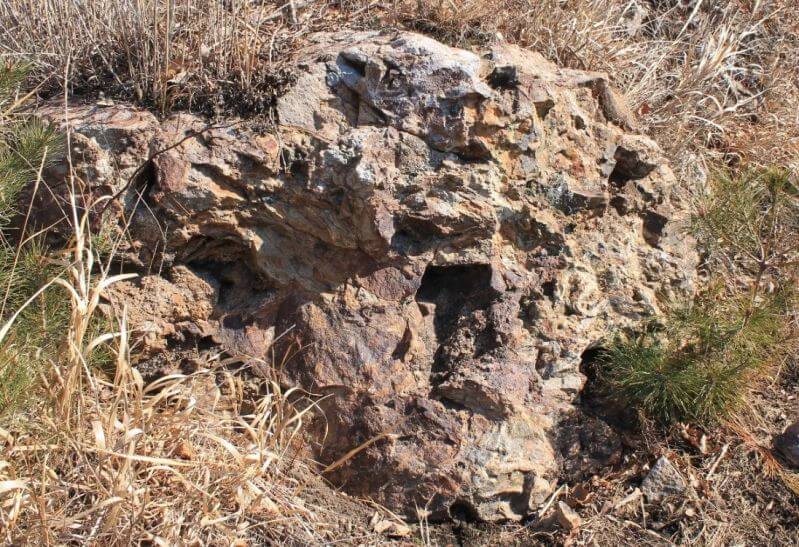
Jangheung Cu-Zn-Ag-Pb project
The Jangheung Cu-Zn-Ag-Pb project lies in the southwestern coastal region of South Korea, about 7km southeast of the town of Jangheung, within Boseong-gun county of Chollanam-Do Province.
Historical exploration by the Korean Institute of Energy Resources (“KIER”) during the 1970s located a ‘cluster’ of 16 polymetallic Cu-Zn-Ag-Pb mineralized breccia pipes at Jangheung. Exploration included soil geochemical surveys, VLF and IP geophysical surveys and limited diamond drilling (12 holes for 1,524m). Most of the drilling was focussed on only three of the breccia pipes (Anomalies I, E & B), recording significant mineralized intersections:
Based on the drill results, KIER (1982) reported a historical inferred mineral resource[1] of 1Mt @ combined 5% Cu-Pb-Zn & 64g/t Ag, at Anomalies E and B. There has been no modern exploration conducted on the Jangheung project since 1982.
Historical Significant Mineralised Drill Intersections, Jangheung Project.
| Breccia Pipe ID | Hole ID | Interval (from - to) | Intersection (m) | Grade Cu (%) | Grade Pb (%) | Grade Zn (%) |
|---|---|---|---|---|---|---|
| Anomaly B | JD-10 | 0 - 146m | 146m | 0.44 | 0.26 | 4.87 |
| Anomaly B | JD-11 | 33 - 102m | 69m | 0.21 | 0.09 | 3.73 |
| Anomaly B | JD-12 | 71 - 105m | 34m | 0.28 | 0.19 | 3.47 |
| Anomaly E | JD-7 | 16 - 24m | 8m | 1.27 | 6.03 | 4.80 |
| Anomaly E | JD-7 | 53 -62m | 9m | 1.10 | 1.27 | 2.20 |
| Anomaly I | JD-1 | 23 -29m | 6m | 0.16 | 2.85 | 7.40 |
NOTES: Silver was not reported. No grade is assumed, but significant silver grades can be expected.
Mineralization at Jangheung consists of high-grade Cu-Zn-Ag-Pb mineralized breccia pipes with a subvertical inverted cone or ‘carrot-shaped’ morphology, associated with the intrusion of Cretaceous diorite porphyry into basement granite gneiss. In places, the diorite porphyry is intensely carbonate altered and contains stockwork and disseminated lower-grade Cu-Zn-Ag-Pb sulphide mineralization.
The polymetallic Cu-Zn-Ag-Pb (± As-Bi-Mo-Ba-Fe-Mn) mineralization at Jangheung is classified as magmatic-hydrothermal intrusion-related breccia pipes, associated with the degassing and de-volatilization of a mineralized diorite porphyry, depositing at relatively deep crustal levels 4-8km.
The breccia pipes occur as a ‘cluster’ of 16 outcrops distributed within a relatively small area of 1500m x 1000m. Anomalous soil geochemistry and geophysical responses suggest some of the pipes are connected at depth. Most of the breccia pipes mapped by KIER remain unexplored. KME considers it highly likely more ‘blind’ pipes can be expected at depth within the Jangheung project area.
Korean Metals Exploration Pty Ltd (“KME”) believes there is excellent potential for a modest-sized mining operation, sourcing high-grade polymetallic ores from multiple pipes to feed a central milling facility. The subvertical geometry of the breccia pipes is amenable to extraction by the novel Sustainable Mining by Drilling method using locally-manufactured mobile crawler track-mounted Pile Top RC Drills.
[1] Cautionary Statement: This resource was classified based upon the Korean Institute of Energy Resources resource estimation classification scheme and reporting nomenclature (1982). The resource estimate is historical and does not comply with current NI43-101 or 2012 JORC Code reporting requirements.
Anomaly B
Anomaly B displays a 150m x 150m strong Cu-Pb-Zn soil anomaly. It has an elliptical-shaped breccia outcrop with150m diameter at surface, perhaps with some WNW structural control.
It was drill tested by KIER (1982) with holes JD-10, JD-11 and JD-12. The drilling confirmed the outcrop at Anomaly B is a breccia pipe with an inverted cone, carrot-shaped morphology.
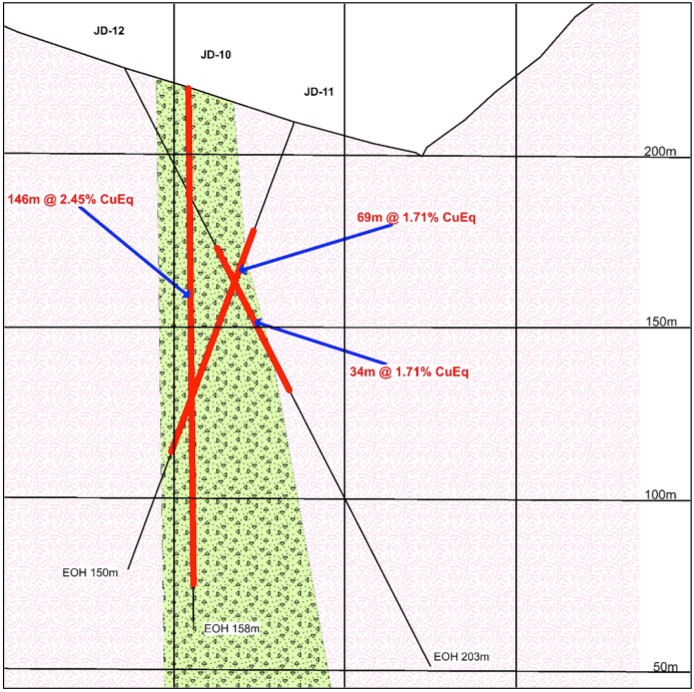
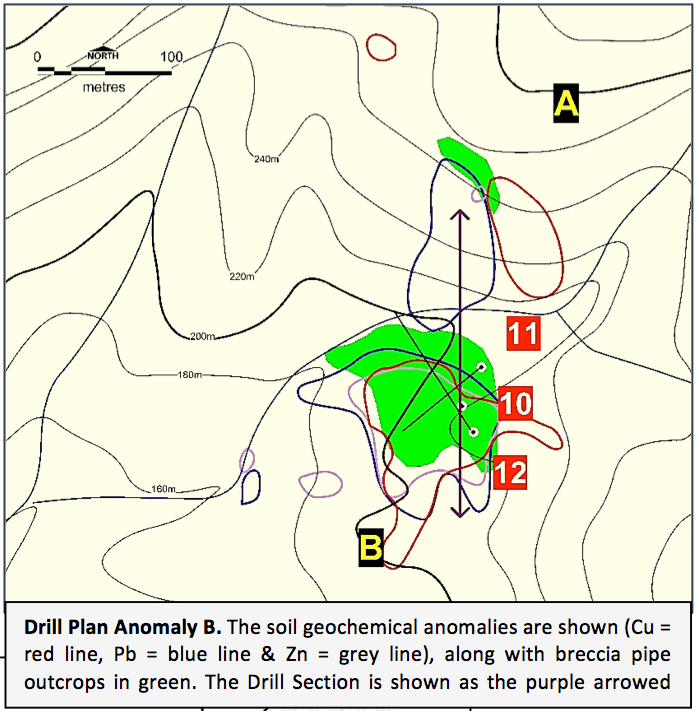
Excellent results were recorded from the 3 drillholes at Anomaly B, including 146.2m @ 2.45% CuEq. The drill results suggest Anomaly B has an Exploration Target of at least 3Mt size grading 1.0-2.5% CuEq.
Anomaly B is the largest breccia pipe mapped at Jangheung. It is a high-priority Exploration Target and additional geophysical surveys and drill testing is warranted in this area.
Anomaly D
Anomaly D has a 25m x 25m breccia outcrop and a coincidental 50m x 10m weak Cu-Pb soil anomaly. A NW-striking mafic dyke (diorite porphyry?) lies to the NW of Anomaly D. Anomaly D was not drill tested by KIER.
Anomaly E
The 75m x 50m breccia outcrop at Anomaly E has a coincidental very strong Cu-Pb-Zn geochemical anomaly over a 200m x 150m area which is connected to Anomaly F.
Anomaly E was tested by drill holes JD-5, JD-6, JD-7 and JD-8, with good intercepts reported in all drill holes except JD-6. The copper assays are particularly noteworthy and indicate the Anomaly E breccia pipe is Cu-enriched compared to the other more Zn-dominant pipes. Mineralized diorite porphyry was intersected on the margin of the breccia pipe.
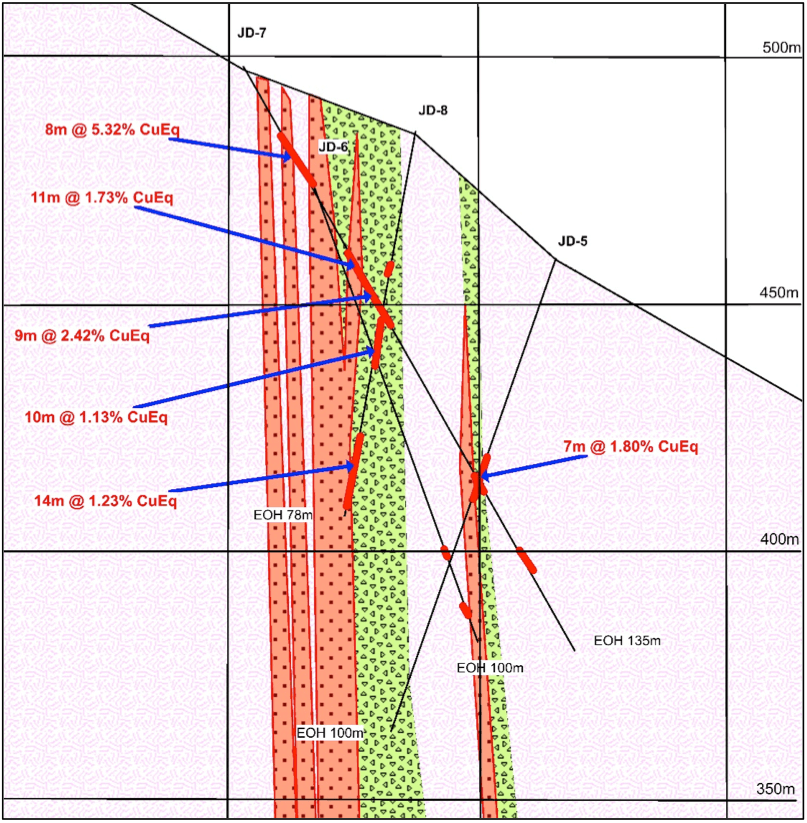
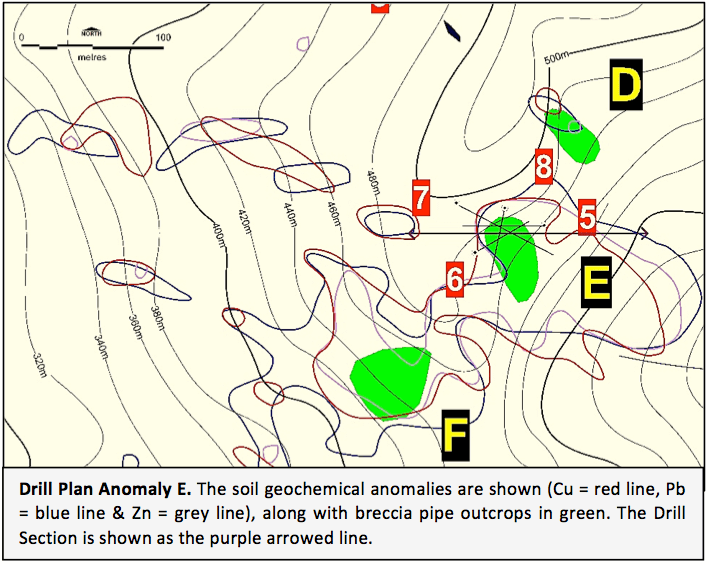
FA 5m deep prospecting pit was excavated at Anomaly E and a bulk sample of high-grade breccia ore material collected for metallurgical testwork (KIER, 1982) which assayed 143g/t Ag, 5.43% Pb, 4.30% Zn, 1.12% Cu, 1.68% Mn.
Anomaly E is regarded as the highest ranked priority target at Jangheung. Additional geophysical surveys and further drill testing is warranted in this area.
Anomaly F
Anomaly F has a 60m x 50m breccia outcrop, with coincidental strong Cu-Pb-Zn soil geochemical anomaly that is connected to Anomaly E.
Anomaly F was not drill-tested by KIER.
Anomaly H
Anomaly H has a 150m x 100m breccia outcrop that exhibits some ENE structural control towards Anomaly I, located about 200m to WSW. A 150m x 100m area of weak Cu-Pb-Zn soil geochemical anomalism is coincidental with the breccia outcrop and a strong EW trending VLF-EM geophysical anomaly. Anomaly H was not drill tested by KIER.
Anomaly I
Anomaly I consists of a 100m x 100m breccia outcrop and a coincidental 100m x 100m area of very strong Cu-Pb-Zn soil geochemical anomalism.
A strong ENE trending VLF-EM geophysical anomaly lies immediately north of the breccia. There is also a NNE trending magnetic low feature immediately to the west of the breccia.

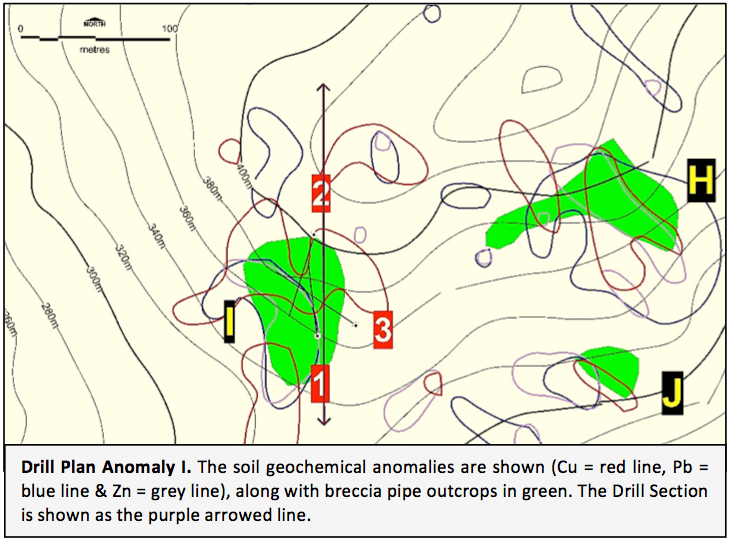
The breccia outcrop was tested by drill holes JD-1, JD-2 and JD-3. Thick Zn-dominant mineralization was intercepted in all holes, associated with stockworks and disseminations within a diorite porphyry intrusion (best result of 6m @ 4.10% CuEq).
Anomaly I is a priority Exploration Target. Geophysical surveys and further drill testing is warranted-recommended in this area.
Anomaly J
Anomaly J has a small 30m x 20m outcrop of breccia and a coincidental small 50m x 25m weak Cu-Pb-Zn soil geochemical anomaly.
Anomaly J was not drill tested.

